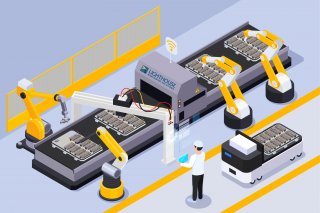Lighthouse: Cleanrooms & Electric Vehicle Batteries
How It’s Made: Electric Vehicle Batteries
Myth or truth: electric vehicle batteries are just as bad for the environment as driving a gas-powered car.
Do you have your answer? Do you think it’s a myth or the truth?
It’s a myth! This myth comes from the fact that electric vehicles have large batteries that can sometimes be found in landfills. Since these batteries take up landfill space, some people have claimed that they are just as bad for the environment as driving a gas-powered car, effectively meaning that money has been wasted on an electric vehicle in an effort to help the environment.
But here’s the thing: gas-powered cars use batteries, too! And electric vehicles batteries are more reliable with a longer lifespan. The batteries they use in electric vehicles can last anywhere from 100,000 to 200,000 miles, which is significantly longer than the average lifespan of 30,000 to 50,000 miles for a gas car’s battery.
So electric vehicles allow us to use fewer fossil fuels and replace batteries less often. But now you might be thinking, “Lighthouse Worldwide Solutions, you make particle counters and are an expert on clean air and cleanrooms. What does that have to do with electric vehicle batteries?”
Good question, reader! Electric vehicle batteries are made in cleanrooms. Because of the delicate nature of the batteries’ ion cells, they must be kept perfectly clean while being made and assembled. So how exactly are electric vehicle batteries made?
Attain The Lithium
Gas-powered cars typically run on lead-acid batteries, but electric vehicles run on lithium-ion batteries.
The first step to making a lithium-ion battery for an electric car is to attain lithium. One way to get lithium is to pump it out of water and allow it to dry in the sun. Once dried out, it can be made into lithium carbonate. Another way to mine lithium is by mining in mountains, rocks, and dirt.
While electric vehicles are supposed to be environmentally friendly, lithium mining for the batteries is less than environmentally friendly. It uses millions of gallons of water to mine for lithium – and then immediately creates an immense amount of waste. Lithium has an incredibly long life and is very usable, but it does have that drawback to mining it.
At the end of the day, while the demand for electric vehicles exists, the demand for lithium to produce the batteries will exist.
Build The Lithium-Ion Cells
After you have the lithium, you need to make it into ion cells. These cells hold the energy and conduct it into a usable form of energy for the car. The dried lithium is formed into an ingot, which is then laminated into a very thin sheet. This process can take some time, as the sheet needs to be very, very thin.
Because the next step is to roll it up!
Once the lithium sheet has been rolled up, it is put into a vacuum oven. This seals it into tightly wound, small cells that store and emit energy. At this point, you are able to test the cells to make sure they are putting off the right voltage.
Depending on the manufacturer, the lamination and rolling of the lithium could be conducted in a cleanroom to prevent contamination.
Assemble The Battery
Once you’ve got the lithium-ion cells, it’s time to make them into the battery. The battery consists of battery modules, electrical connections, and cooling equipment. This part of the process happens in a clean room!
Any kind of contamination of the battery can be dangerous because it could cause the battery to short. Thus, it is recommended to build the battery in a cleanroom with a classification of ISO Class 7 or ISO Class 6.
Depending on the manufacturer, the battery might be assembled by hand or by machine. Now, this does present an opportunity to prevent contamination in this decision. In a cleanroom, operators are the number one source of contamination. Machines can create particles, but not nearly as many as humans can introduce. The initial sunk cost of the machinery might be more expensive than using operators, but, over time, it can save money through decreased labor costs and decreased contamination.
Costs in the battery assembly stage should not be overlooked because it is one of the most expensive portions of battery production. The packaging and assembling of the battery makes up about 14% of the total cost of production.
Cleanrooms & Electric Vehicle Batteries
At the end of the day, when the battery can no longer power the car, the lithium allows it to still be used as energy storage elsewhere. That’s the power of lithium, although the mining practices need work to be considered environmentally friendly.
So what do you think? With mining and manufacturing practices in mind, is lithium batteries still worth it in electric vehicles?
What we know is that the production of electric vehicles batteries – along with thousands of other everyday essentials – are produced in cleanrooms to prevent contamination, protect the consumer, and save the manufacturer from incurring the costs of contamination. These are costs like lost productivity, product recalls, damaged reputation, and more.
This content was first posted on the Lighthouse website.

